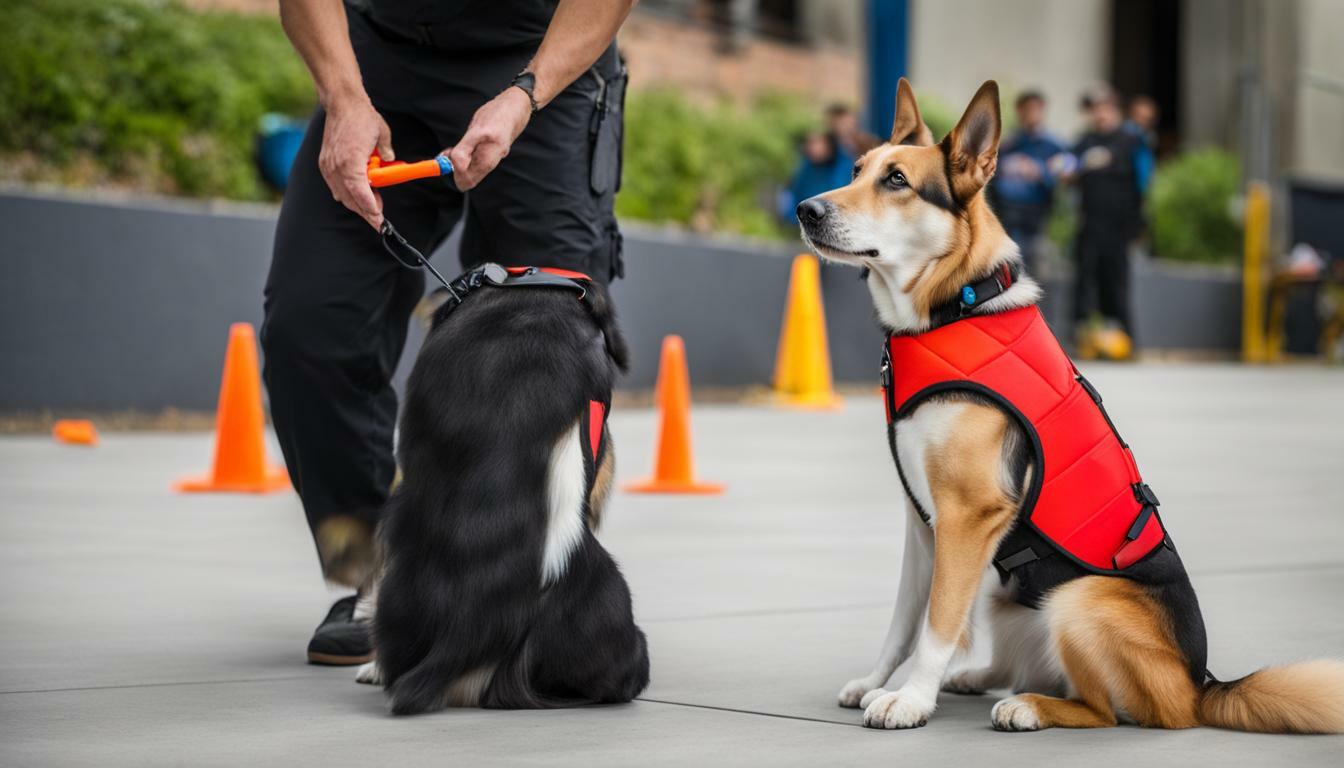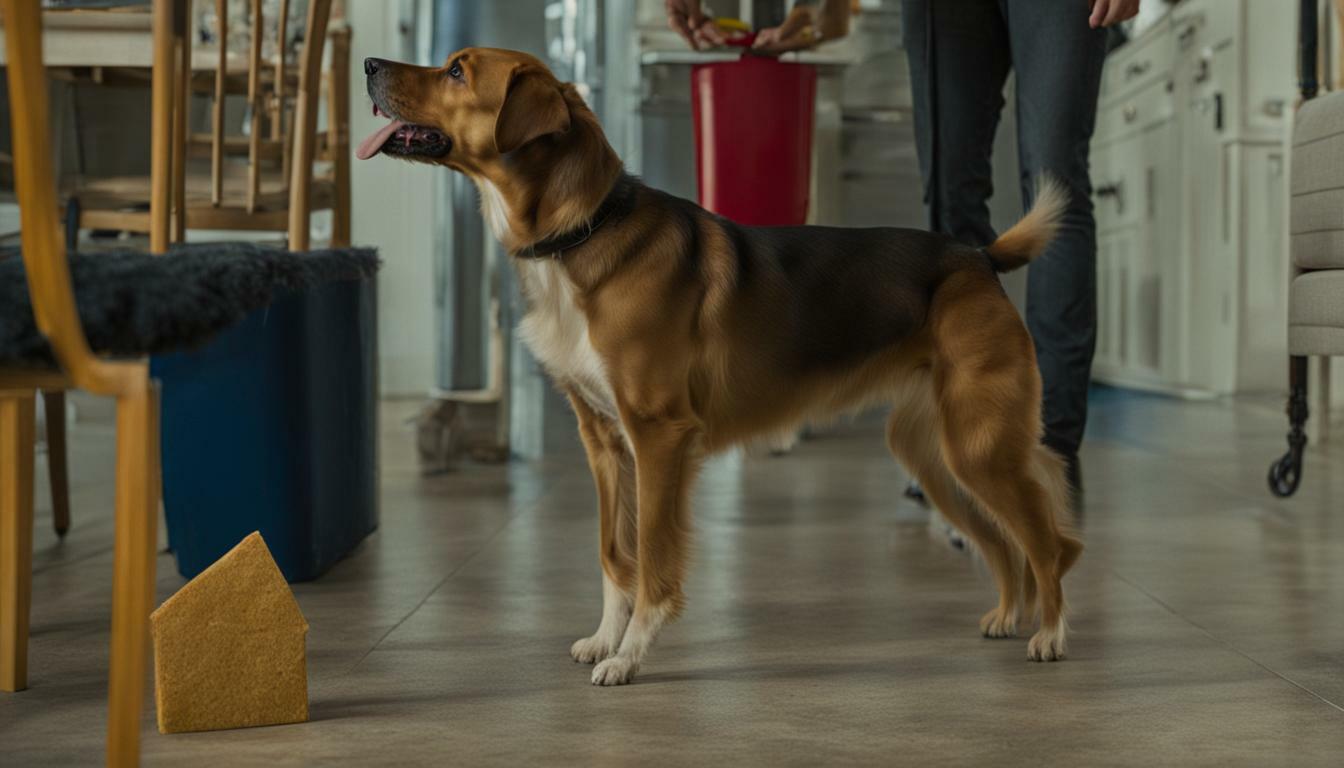If you or a loved one has a disability, a service dog can make a significant difference in everyday life. With proper training, service dogs can assist their owners with a range of tasks, providing both physical and emotional support. However, training a service dog requires patience, dedication, and a strategic approach.
In this comprehensive guide, we will provide you with a step-by-step approach to effectively train a service dog. By following these guidelines, you can empower your canine companion to assist in everyday tasks with confidence and reliability.
- Training a service dog requires patience, dedication, and a strategic approach.
- Proper training can help service dogs provide physical and emotional support to individuals with disabilities.
- With a step-by-step approach, you can effectively train your service dog to assist in everyday tasks with confidence and reliability.
- The foundation of service dog training involves establishing basic obedience and task-specific training.
- Regular recertification and continuing education are important to ensure that your service dog maintains its skills.
Understanding the Role of a Service Dog
Service dogs are specially trained to assist individuals with disabilities, providing life-changing support and companionship. They are trained to perform specific tasks and assist their owners in daily activities, enabling them to live with greater independence and confidence.
Service dog training requires time, dedication, and commitment from both the trainer and the dog. The training process involves teaching the dog how to perform specific tasks related to the owner’s disability, as well as developing a strong bond between the dog and the owner.
When selecting a candidate for service dog training, it’s important to consider factors such as breed suitability, temperament, and health. Not all dogs are suitable for service dog training, and it’s important to work with a qualified trainer to ensure that the dog has the necessary skills and temperament to perform the required tasks and work in various public settings.
Service dog training programs typically consist of basic obedience training, task-specific training, public access training, and socialization. The training process can take several months to years, depending on the needs of the individual and the abilities of the dog.
It’s important to note that service dogs are not pets but working animals. They have legal rights and responsibilities, and their owners must follow proper etiquette and guidelines when using their service dogs in public. Failure to do so can result in legal consequences and potentially harm the reputation of service dog handlers.
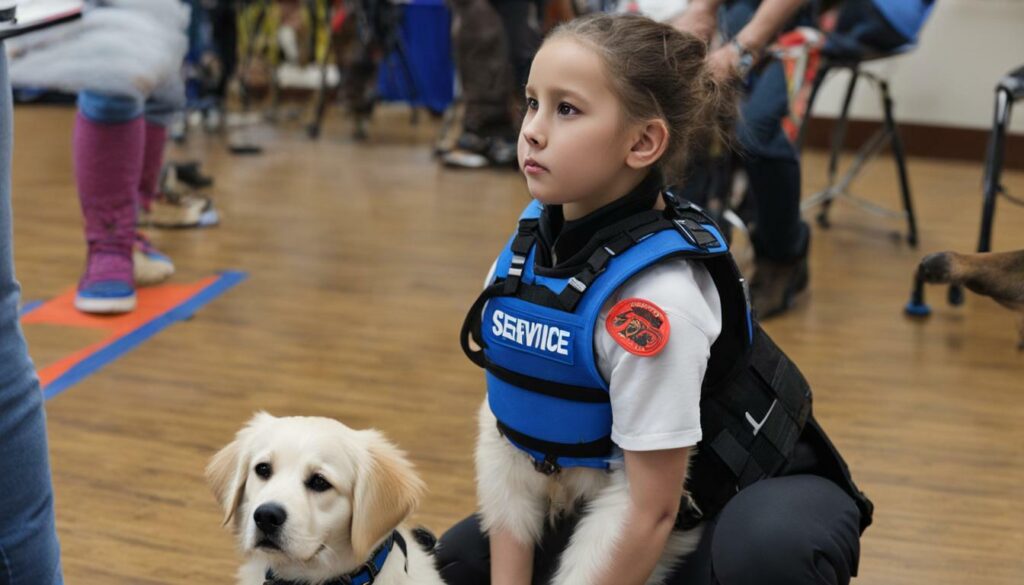
Overall, service dog training is a challenging but rewarding experience for both the trainer and the dog. With proper training and guidance, service dogs can transform the lives of individuals with disabilities, enabling them to live with greater independence and dignity.
Obtaining the Right Candidate for Service Dog Training
When it comes to training a service dog, selecting the right candidate is crucial. Not every dog is suited for service dog training, so it’s important to take the time to evaluate potential candidates before committing to the training process.
Service dog training tips:
- Consider the breed and size of the dog. Not all breeds are well-suited for service work, so research breeds known for their intelligence, trainability, and temperament.
- Look for dogs with a calm and adaptable personality, as they will be better equipped to handle the demands of service work.
- Check for any health issues that could affect the dog’s ability to perform tasks or cause discomfort during training.
- Consider the dog’s age, as younger dogs may be more adaptable to training and socialization.
- Observe the dog’s behavior and temperament in various environments and situations to ensure they are a good fit for service work.
Service dog training techniques:
Once you have selected a potential candidate, it’s important to evaluate their temperament and trainability. Some effective techniques to ensure the dog is a good fit for service work include:
- Observing their response to basic commands, such as sit and stay, to assess their trainability.
- Exposing the dog to different environments and situations to assess their adaptability and socialization skills.
- Assessing their ability to focus and remain calm in distracting environments, as this is crucial for service work.
- Working with a professional trainer or behaviorist to evaluate the dog’s suitability for service work and develop a training plan.
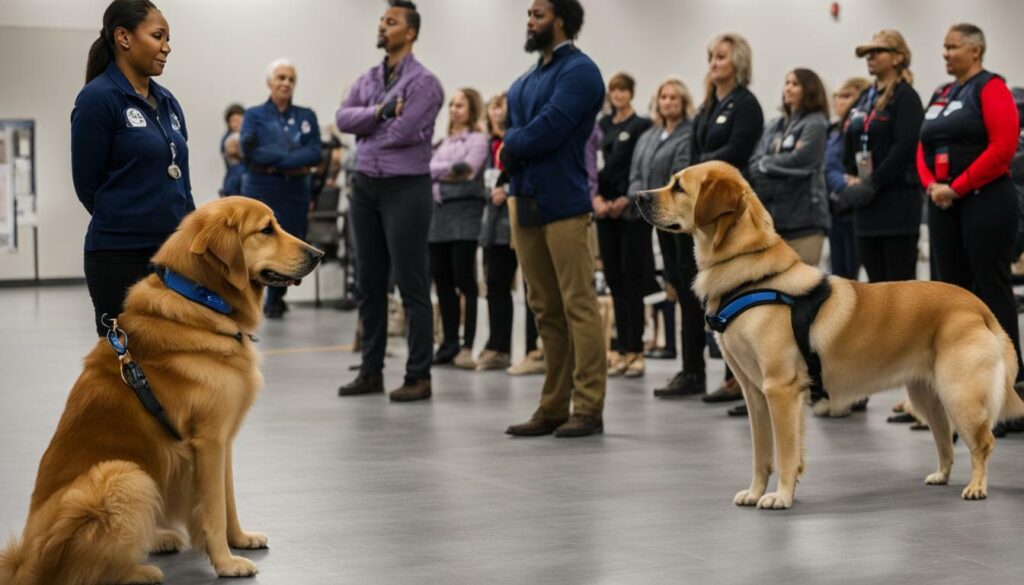
Overall, selecting the right candidate for service dog training requires careful consideration and evaluation. By following these service dog training tips and techniques, you can increase your chances of finding a dog that is well-suited for service work and successfully complete the training process.
Laying the Foundation: Basic Obedience Training
Before diving into service-specific tasks, it’s essential to establish a strong foundation of basic obedience training. This will not only make it easier to teach your service dog more advanced commands but also provide a solid understanding of expected behavior, making it easier to manage the dog in public settings.
Some of the essential commands for a service dog include “sit,” “stay,” “heel,” and “come.”
Implementing these commands requires consistency, patience, and positive reinforcement. When teaching “sit,” for instance, place a treat close to the dog’s nose and slowly move it up while saying “sit.”
When the dog sits, praise, and reward them with the treat. Repeat the process consistently, gradually reducing the use of treats and incorporating the word “sit” while reducing hand gestures until the dog understands what is expected of them, and they perform the command with just the verbal cue.
One common technique that can be used in training a service dog is known as shaping, which involves breaking down desired behaviors into small, manageable steps and gradually rewarding the dog until they master each step. Thus, shaping helps dogs learn complex commands like opening doors, fetching items, or alert barking, among other tasks.
Training your service dog should be both fun and challenging to keep your dog engaged. Utilizing positive reinforcement will help establish a healthy relationship between you and your dog, making training a pleasant experience for both of you.
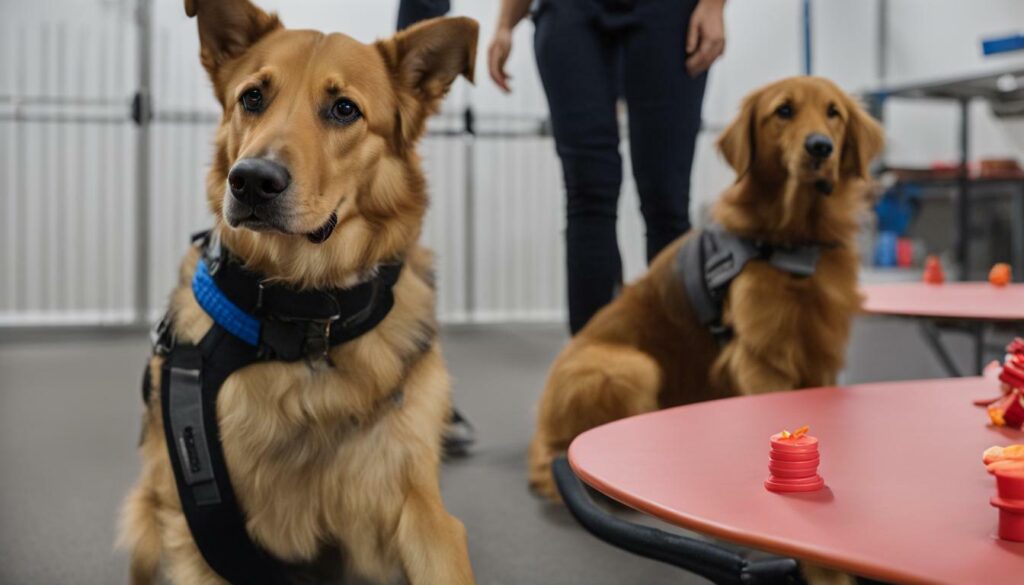
It’s helpful to break each task into small, manageable steps and keep training sessions short to prevent your dog from becoming overwhelmed or exhausted. Dogs learn through repetition, so it’s essential to be consistent with commands, praise, and rewards. It’s also crucial to avoid punishing your dog for making mistakes, as this can discourage them from trying new things. Always reward good behavior and redirect negative behavior positively to achieve the best results.
Task-Specific Training for Service Dogs
Once your service dog has mastered basic obedience training, it’s time to move on to task-specific training. This is where your service dog will learn the tasks that are most relevant to your disability and daily routine. With consistent and patient training, your service dog will become a reliable helper in your everyday life.
When training task-specific behaviors, it’s important to break the behavior down into small steps and use positive reinforcement to encourage progress. Start by introducing the behavior in a controlled environment without distractions. Once your dog has mastered the behavior without distractions, gradually increase the level of difficulty by adding distractions and practicing in different locations.
Some common task-specific behaviors for service dogs include:
- Retrieving objects: Your service dog can learn to pick up dropped items off the floor, retrieve specific objects, and deliver items to you on command.
- Opening doors: Your service dog can learn to open doors by pushing on them with their nose or paw, or pulling on accessible door handles.
- Providing emotional support: Your service dog can learn to provide comfort and support during times of emotional distress. This can be achieved through cuddling, licking, or other gentle behaviors.
With each task-specific behavior that you teach your service dog, remember to practice in a variety of settings and reinforce positive behavior consistently. Consistency is key to ensuring that your service dog maintains their learned behaviors and continues to be an effective helper in your daily life.
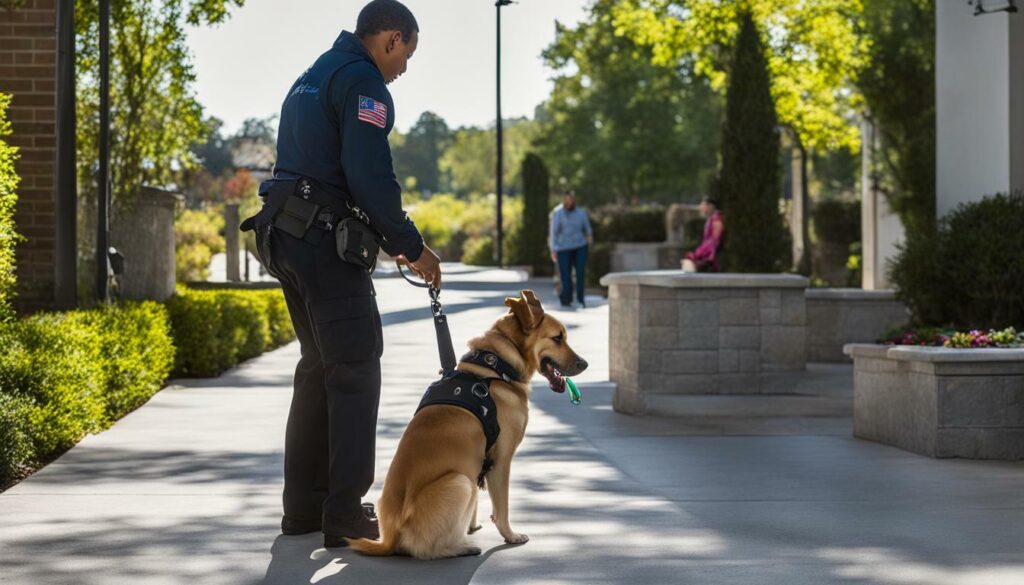
1. Start with basic obedience training: Before moving onto task-specific training, ensure that your service dog has a strong foundation in basic obedience commands such as ‘sit’, ‘stay’, and ‘come’.
2. Choose tasks that are relevant to your disability: Identify tasks that your service dog can perform to help you with everyday tasks related to your disability.
3. Break down the behavior into small steps: Introduce each behavior in a controlled environment and gradually increase the level of difficulty.
4. Use positive reinforcement: Reward your service dog with treats and praise when they exhibit the desired behavior. Consistency in positive reinforcement will encourage your service dog to repeat the behavior.
5. Practice in different settings: Practice the behavior in a variety of settings and gradually increase the level of distraction.
6. Reinforce positive behavior consistently: Consistency is key to maintaining learned behaviors.
Public Access Training and Socialization
Public access training and socialization are crucial components of a comprehensive service dog training program. Service dogs must be well-behaved and relaxed in public settings to effectively assist their handlers. This section will guide you through the process of acclimating your service dog to different environments, distractions, and interactions with people and other animals.
Service dog training tips:
- Expose your service dog to different environments and stimuli.
- Introduce your service dog to various people and animals to reinforce proper behavior.
- Teach your service dog to stay focused on their handler amidst distractions.
- Train your service dog to navigate elevators, escalators, and stairs safely.
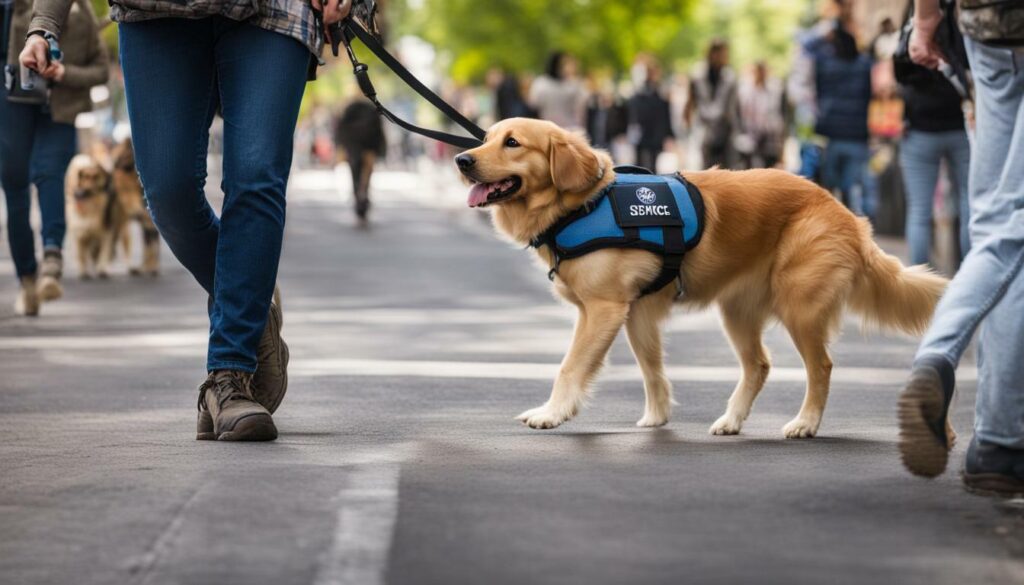
When training your service dog for public access, it’s important to practice in various settings, including busy streets, parks, and other public areas. Gradually expose your dog to new environments and distractions, such as loud noises, other dogs, and unfamiliar people. This will help your service dog become less reactive and more focused on their handler.
Additionally, socialization plays a critical role in service dog training. Teaching your service dog to interact appropriately with people and animals is essential to ensuring a safe and enjoyable experience for everyone involved. Encourage your service dog to remain calm and well-behaved in public situations, and reinforce positive behaviors with treats, praise, and affection.
Advanced Training and Problem-Solving
After your service dog has mastered basic obedience and task-specific training, it’s time to move on to more advanced skills. This stage of training focuses on refining existing behaviors and teaching new ones that are specific to your needs.
One effective technique is called “chaining,” which involves linking multiple behaviors together to complete a more complex task. For example, teaching your service dog to open a door might involve a series of behaviors such as standing on their hind legs, using their nose to push the door, and then using their paw to pull the door open.
Another important aspect of advanced training is problem-solving. Service dogs may encounter new situations or tasks that they have not been specifically trained for. It’s important to teach your dog how to think critically and problem-solve on their own, with guidance from their handler.
During this stage of training, it’s essential to maintain consistency and positive reinforcement. Consistent practice and praise will help your service dog remain confident and engaged in their work.

Overall, advanced training and problem-solving are crucial components of service dog training. By refining skills and teaching problem-solving strategies, your service dog will be better equipped to assist you in a range of situations.
8. Maintaining and Reinforcing Learned Behaviors
Consistency and positive reinforcement are key to maintaining your service dog’s training. Once your dog has learned a new behavior, practice it regularly in different environments to reinforce the behavior and ensure it becomes a habitual response.
Make sure to consistently reward good behavior with treats or praise. If your dog begins to exhibit undesirable behaviors, avoid reprimanding them. Instead, redirect their attention to a positive behavior and reward them when they exhibit that behavior.
It’s important to remember that dogs, like humans, can experience burnout. Avoid overworking your service dog and allow them plenty of rest and relaxation time. Incorporate fun activities and playtime into your routine to keep your dog mentally and emotionally stimulated.
Regularly assess your dog’s training progress and address any weaknesses or areas of improvement. Don’t hesitate to seek guidance from a professional trainer if you encounter any challenges during the training process.
Remember, maintaining a strong bond with your service dog is essential to their continued success as a trained companion. Take the time to play and bond with your dog, and prioritize their physical and emotional well-being.
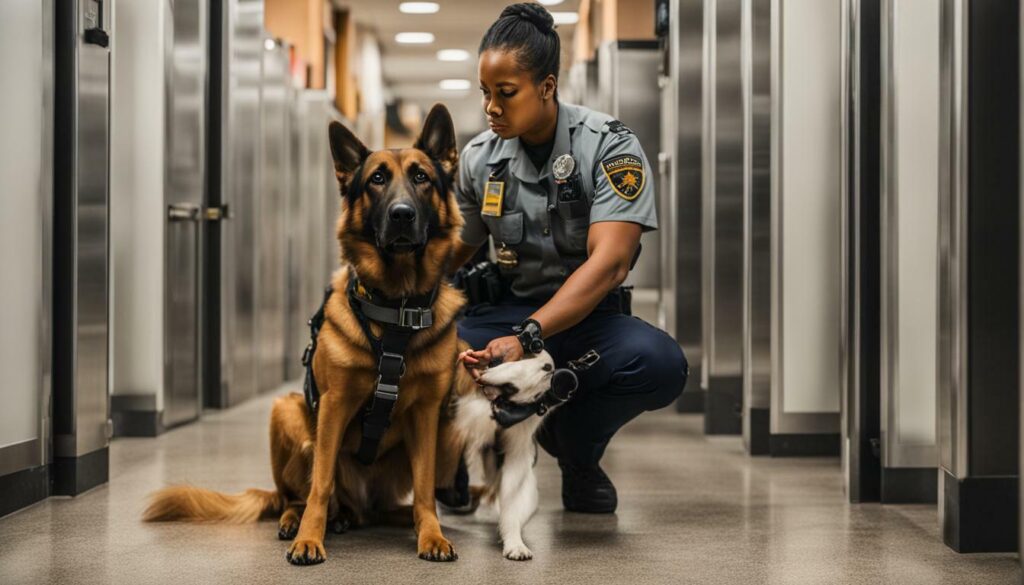
Service dog training is not just about teaching specific tasks, but also about building a strong bond between the dog and the handler. This bond is essential for effective teamwork and trust-based communication. Here are some tips for fostering a strong bond with your service dog:
- Spend quality time together: Regularly spending time with your service dog outside of training sessions can help strengthen your bond. Take your dog for walks, play games together, and engage in activities that you both enjoy.
- Use positive reinforcement: Positive reinforcement, such as praise and treats, can help create a positive association between you and your service dog. Reward good behavior and offer encouragement to build your dog’s confidence and trust in you.
- Communicate clearly: Consistent and clear communication is key to effective teamwork. Use commands and cues consistently, and ensure that your body language and tone of voice match the intended message.
- Be patient and understanding: Dogs, like humans, have good days and bad days. Be patient and understanding with your service dog, and avoid getting frustrated or angry. Remember, building a strong bond takes time and effort.
By following these tips, you can help build a strong bond with your service dog that will enhance your training process and improve your teamwork.
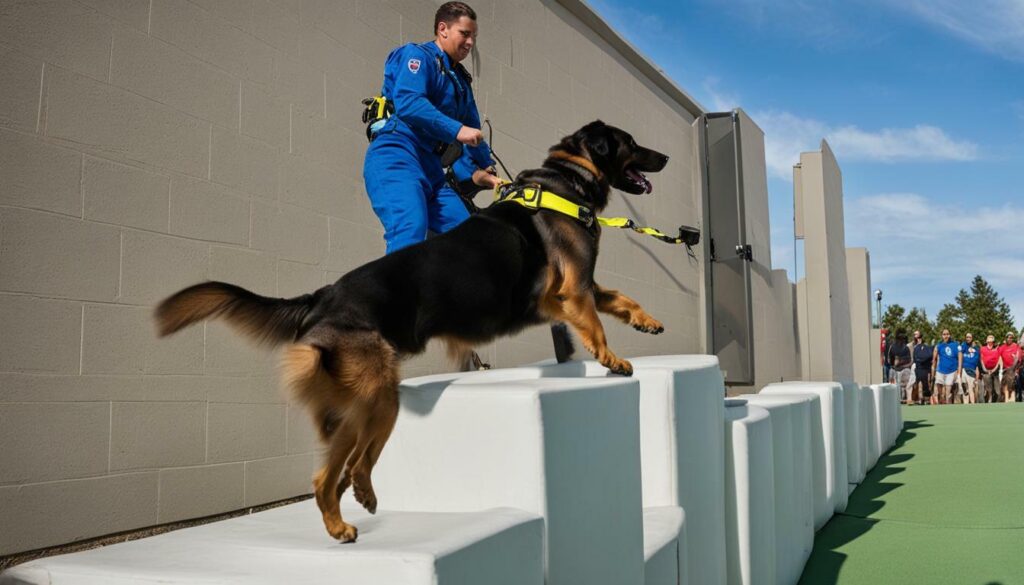
Additionally, consider seeking support from a professional service dog trainer or joining a service dog training program to further enhance your skills and knowledge. These resources can provide valuable tips, advice, and guidance to ensure that you and your service dog are on the same page and working together effectively.
Legal Rights and Responsibilities of Service Dog Handlers
Service dogs play a critical role in enhancing the quality of life for individuals with disabilities. Service dog handlers have legal rights and responsibilities to ensure that their dogs receive proper training and are equipped to perform essential tasks that enhance the owner’s independence and well-being. It’s important to understand these rights and responsibilities to navigate public spaces confidently and avoid any legal issues.
Laws and Regulations
Service dogs and their handlers are protected under the Americans with Disabilities Act (ADA). This law prohibits discrimination against individuals with disabilities and allows service dogs to accompany their owners in public areas such as restaurants, stores, and transportation systems. Under the ADA, service dogs are not considered pets, and businesses cannot charge extra fees or impose additional restrictions on their presence.
It’s important to note that service dogs must be trained to perform specific tasks directly related to the owner’s disability. Emotional support animals, which provide comfort and companionship but do not perform specific tasks, are not considered service animals under the ADA. However, they may be allowed in certain situations under other laws, such as the Fair Housing Act.
Public Accommodation
Service dogs must be allowed to accompany their owners in all public areas, including restaurants, stores, and transportation systems. Handlers should always have documentation or identification for their service dogs, although it’s not legally required. In the absence of an obvious disability, it’s inappropriate for businesses or individuals to question the handler about their disability or ask the service dog to demonstrate its trained tasks.
Etiquette for Handlers
Service dog handlers should be respectful of the public and maintain control over their dogs at all times. The service dog should be well-behaved and non-disruptive in public areas. Handlers should not allow their dogs to interact with other animals, eat food off the table, or block walkways. It’s important to clean up after the dog and dispose of waste properly.
Service Dog Training Program
Training a service dog takes time, effort, and dedication. Various service dog training methods and programs are available, including self-training, professional training, and hybrid models. Service dog handlers should choose a training program that meets their needs and provides adequate support and resources to ensure that both the dog and the handler are prepared for public access.
Service Dog Training Methods
There are various service dog training methods available, including positive reinforcement, clicker training, and shaping. Positive reinforcement is based on rewarding desired behaviors, while clicker training uses a distinct sound to signal a correct behavior. Shaping involves gradually shaping behaviors until the desired task is accomplished. The most effective training method will depend on the dog’s personality, the handler’s training experience, and the specific tasks the dog needs to learn.
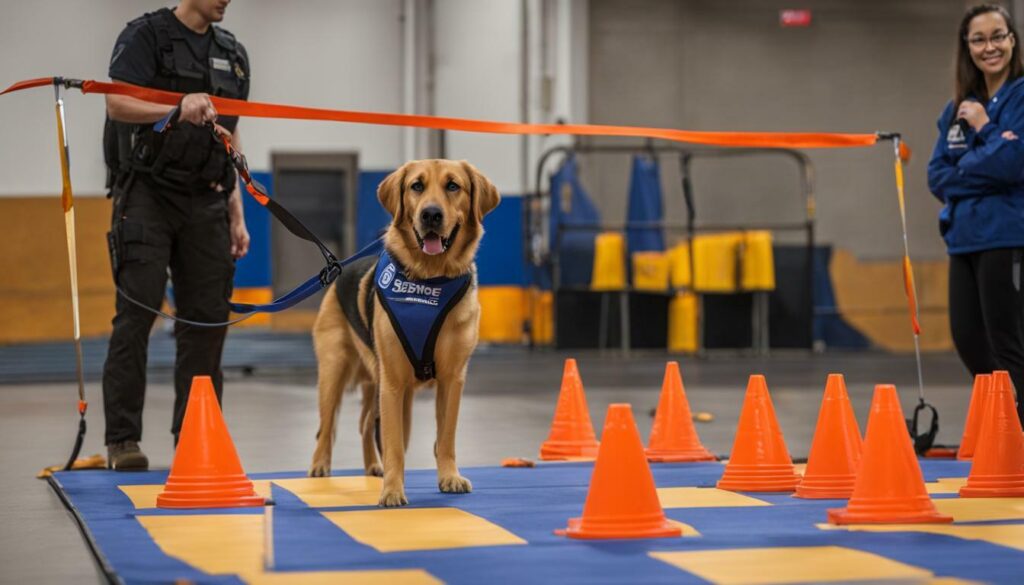
Service dog handlers have legal rights and responsibilities that should be taken seriously. Understanding the laws and regulations governing service animals, maintaining proper etiquette in public areas, and following a comprehensive service dog training program are all essential to ensure a successful partnership between the handler and the service dog. With proper training and support, service dogs can enhance the quality of life for their owners, promoting independence and improving overall well-being.
Recertification and Continuing Education
Service dog training is an ongoing process that requires consistent effort and dedication. It is essential to regularly evaluate your service dog’s skills and behavior to ensure that they remain effective in their role. Recertification is the process of testing and evaluating your dog’s training to maintain their status as a service dog.
Each certification organization has its own guidelines for recertification, which may include retesting the dog’s obedience, task performance, and public access skills. Recertification is typically required annually, biannually, or every three years, depending on the organization. Check with your certifying agency to determine their specific requirements.
Continuing education is another important aspect of service dog training. It involves staying up to date with current training techniques and learning new skills to enhance your dog’s abilities. Service dog training programs, seminars, and workshops are excellent ways to continue your education and improve your service dog’s training.
It is important to note that service dog handlers are responsible for ensuring their dog’s ongoing training and recertification. Neglecting to maintain your service dog’s training can result in the revocation of their certification and the loss of access rights. Make sure to stay up to date with your dog’s training and continue to invest time and effort into their development.
Overall, recertification and continuing education are crucial components of service dog training. By regularly evaluating and enhancing your service dog’s skills and knowledge, you can ensure that they remain effective in their role and improve their well-being. Consult with your certifying organization and explore educational opportunities to maintain your service dog’s training program.

Training a service dog requires dedication, patience, and a willingness to learn. Thankfully, there are many resources available to assist you in your training journey. Whether you are a beginner or an experienced trainer, these resources offer valuable information, support, and guidance to make the process easier and more effective.
Recommended Books
| Book Title | Author |
|---|---|
| Service Dog Training Manual | Sue Ailsby |
| The Right Dog for the Job: Ira’s Path from Service Dog to Guide Dog | Dorothy Hinshaw Patent |
| Teamwork: A Dog Training Manual for People with Disabilities | Stewart Nordensson |
Online Resources
- Assistance Dogs International (ADI) – a coalition of non-profit organizations that provide assistance dogs to people with disabilities.
- National Service Animal Registry (NSAR) – a registry that provides identification, certification, and training for service animals.
- Service Dog Academy – an online training program that offers courses on service dog training and behavior modification.
Organizations
There are many organizations that specialize in training and placing service dogs, as well as providing support and resources for handlers. Some of these organizations include:
- Canine Companions for Independence
- Guide Dogs for the Blind
- National Education for Assistance Dog Services (NEADS)
By utilizing these resources, you can enhance your service dog training techniques and methods and develop a stronger bond with your furry companion. Remember, the key to successful service dog training is patience, consistency, and dedication to the process.
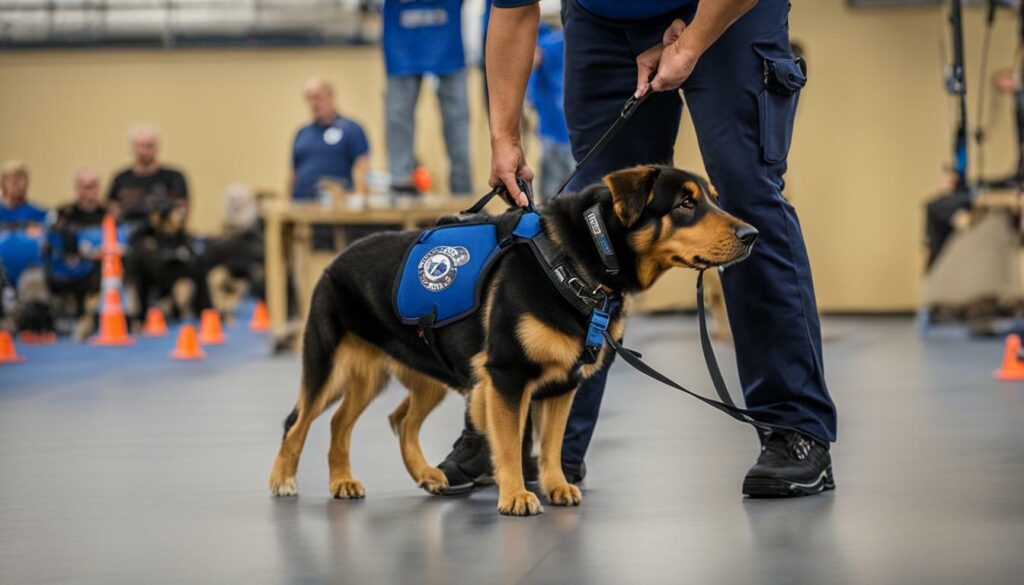
Training a service dog is a challenging but rewarding process that requires dedication, patience, and a deep commitment to the well-being of both you and your canine companion. By following the step-by-step guide outlined in this article, you can empower your service dog to assist you in everyday tasks with confidence and reliability.
Remember, a service dog is more than just a pet; they are an important part of your support system. Building a strong bond between you and your dog is essential for effective teamwork, and ongoing training and education are crucial to maintaining your service dog’s skills.
By investing time and effort into a service dog training program, you can enjoy the benefits of having a highly skilled and reliable companion to assist you with a range of tasks. Whether you are a beginner or an experienced trainer, there are many resources available to support you on your journey towards successful service dog training.
Thank you for reading our step-by-step guide on service dog training!
FAQ
Q: What is the purpose of this guide?
A: The purpose of this guide is to provide a step-by-step approach to effectively train a service dog.
Q: Why is understanding the role of a service dog important?
A: Understanding the role of a service dog is important to comprehend their responsibilities and benefits they provide to individuals with disabilities.
Q: How do I find the right dog for service dog training?
A: Finding the right dog for service dog training involves considering factors such as breed suitability, temperament, and health. Tips and techniques to evaluate potential candidates are provided.
Q: What does basic obedience training entail?
A: Basic obedience training focuses on establishing a strong foundation of essential commands such as sit, stay, and heel.
Q: How do I train my service dog for specific tasks?
A: This section provides step-by-step instructions for teaching tasks related to the owner’s disability, such as retrieving objects, opening doors, and providing emotional support.
Q: How do I socialize my service dog for public access?
A: Socialization is important for service dogs to behave well in various public settings. This section guides you through the process of acclimating your dog to different environments, distractions, and interactions.
Q: What should I do during advanced training and problem-solving?
A: This section covers advanced training techniques and addresses common challenges that may arise during the training process.
Q: How can I maintain and reinforce my service dog’s learned behaviors?
A: This section provides tips for ongoing practice, reinforcement strategies, and troubleshooting common training issues.
Q: How can I build a strong bond with my service dog?
A: Building a strong bond with your service dog involves techniques for strengthening the human-animal bond, fostering trust, and promoting a positive working relationship.
Q: What are the legal rights and responsibilities of service dog handlers?
A: This section provides an overview of the laws and regulations governing service dogs, including access rights, public accommodation, and etiquette for handlers.
Q: How important is recertification and continuing education for service dogs?
A: Regular recertification and continuing education are essential to ensure your service dog maintains their skills and stays up to date with any new training techniques or requirements.
Q: Are there resources available for service dog training?
A: Yes, this section provides a list of recommended resources, including books, websites, and organizations, that can assist you in your service dog training journey.
Q: What should I do after completing this guide?
A: After completing this guide, congratulations! Remember, training a service dog requires patience, consistency, and a deep commitment to the well-being of both you and your canine companion.
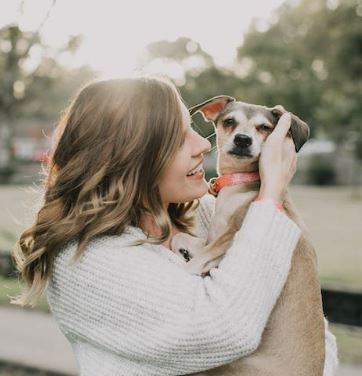
Marissa Delotta, 36, from Dayton, Ohio, is the creative force behind Roverboard.com, a beloved online destination for dog lovers. As a dedicated mom and canine enthusiast, Marissa combines her family experiences with her love for dogs to offer a platform where dog owners can exchange tips, heartwarming stories, and advice. Her website has become a vibrant community for sharing the joys of dog parenting. In her free time, Marissa enjoys exploring dog parks with her family and volunteering at local animal shelters.

